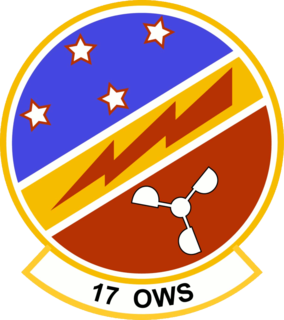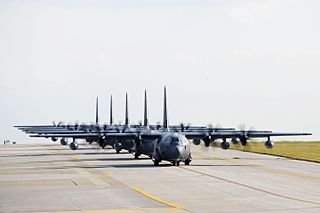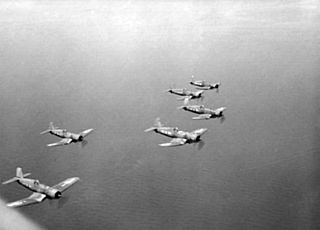
14 Squadron RNZAF is a squadron of the Royal New Zealand Air Force. In 2015 the squadron was re-raised and equipped with 11 Beechcraft T-6 Texan II. A new aerobatic display team called the Black Falcons was also formed using the new aircraft. They replaced the RNZAF display team known as the Red Checkers.
No. 15 Squadron was a fighter squadron of the Royal New Zealand Air Force that was formed in June 1942. It served in Tonga, Guadalcanal, New Georgia, Espiritu Santo, Bougainville and Green Island. The squadron was equipped with Kittyhawk and, later, F4U Corsair fighters. The squadron was disbanded in October 1945.

No. 486 (NZ) Squadron was a fighter squadron established for service during the Second World War. It was a New Zealand squadron formed under Article XV of the Empire Air Training Plan. Although many of its flying personnel were largely drawn from the Royal New Zealand Air Force, the squadron served in Europe under the operational and administrative command of the Royal Air Force.

No. 488 Squadron was the name given to two distinct Royal New Zealand Air Force squadrons during the Second World War. Both were formed under Article XV of the Empire Air Training Scheme and served under the operational command of the Royal Air Force.

No. 489 Squadron was a torpedo bomber squadron established for service during the Second World War. It was a New Zealand squadron formed under Article XV of the Empire Air Training Plan. Although many of its flying personnel were largely drawn from the Royal New Zealand Air Force, the squadron served in Europe under the operational and administrative command of the Royal Air Force as part of Coastal Command.

No. 41 Squadron was a Royal Australian Air Force (RAAF) transport squadron of World War II. It was formed in August 1942 and operated flying boats in the South West Pacific area. The squadron was disbanded in September 1945.

No. 1 Squadron RNZAF was a New Zealand reconnaissance and patrol bomber squadron operating in the Pacific Theatre during World War II. After the war the squadron served in the transport and VIP role.
No. 4 Squadron RNZAF was a Royal New Zealand Air Force (RNZAF) patrol bomber unit that served in the South Pacific during World War II.
No. 8 Squadron RNZAF was a New Zealand Bomber Reconnaissance squadron in the South Pacific during World War II.
No. 9 Squadron RNZAF was a New Zealand bomber reconnaissance squadron in the Pacific Theatre of World War II.

The 17th Operational Weather Squadron is a unit of the military of the United States. Based at Hickam Air Force Base in Hawaii, it covers weather for the largest geographical area in the world.

The 17th Special Operations Squadron is an inactivated unit, previously part of the United States Air Force 353d Special Operations Group at Kadena Air Base, Japan. It operated MC-130J Commando II aircraft providing special operations capability. Air crews are specially trained in day and night, low-level delivery of troops and equipment via airdrop or airland operations and flying using night vision goggles.** The 17th Special Operatopns Squadron has been re-activated as of late April 2022, and is flying the AC-130J.

The 63rd Air Refueling Squadron, sometimes written as 63d Air Refueling Squadron, is a United States Air Force Reserve squadron, assigned to the 927th Operations Group at MacDill Air Force Base, Florida. It is a reserve associate of the active duty 91st Air Refueling Squadron. The squadron operates the KC-135 Stratotanker aircraft conducting air refueling missions.

The XIII Bomber Command was an inactive United States Army Air Forces formation. It was last assigned to Thirteenth Air Force, based at Clark Field, Luzon, Philippines. It was inactivated on 15 March 1946.

The 350th Fighter Group was an air combat unit of the United States Army Air Force formed in 1942 and inactivated in 1945. The fighter group consisted of 345th, 346th and 347th Fighter Squadron. The group was formed in England in 1942 flying Bell P-39 Airacobras and participated in the Mediterranean and North African Campaigns of World War II. 350th Fighter Group was based in North Africa, in Algeria and Morocco from January to July 1943. They then moved on to the Mediterranean islands of Sardinia and Corsica in November 1943 and February 1944 and were based in Italy in from September 1944 to July 1945. After the group was inactivated on 7 November 1945 at Seymour Johnson Air Force Base following the end of the war. It was redesignated the 112th Fighter Group and placed under the control of the Pennsylvania Air National Guard in 1946.
No. 19 Squadron was a squadron of the Royal New Zealand Air Force. Formed on 10 December 1941 at RNZAF Station Ohakea from members of No. 3 Squadron equipped with P-40 Kittyhawk and later with the Chance-Vought F4U-1 Corsair fighter bombers.
No. 20 Squadron was a squadron of the Royal New Zealand Air Force. It was first established at as an army co-operation unit, serving in this role between 1942 and 1943. In January 1944, the squadron was reformed as a fighter unit at equipped with P-40 Kittyhawks. It later flew F4U-1 Corsair fighter bombers.

No. 18 Squadron was a squadron of the Royal New Zealand Air Force. Formed in June 1943 at RNZAF Base Woodbourne, the squadron was initially equipped with Curtiss P-40 Kittyhawks, before converting to F4U-1 Corsair fighter bombers in 1944. The squadron fought in the Pacific theatre during World War II, flying combat operations against Japanese forces until it was disbanded in late 1945.
No. 23 Squadron was a squadron of the Royal New Zealand Air Force. It was formed in August 1944 at RNZAF Station Ardmore equipped with the F4U-1 Corsair fighter bomber.

Michael James Herrick, was a New Zealand flying ace of the Royal Air Force (RAF) during the Second World War. He is credited with having shot down at least six enemy aircraft.













